Choosing the right road bike size is crucial for optimal performance, comfort, and efficiency. This guide helps riders select a bike that fits their body proportions perfectly, ensuring a enjoyable and efficient riding experience.
1.1 Why Bike Size Matters for Performance and Comfort
A properly sized road bike ensures optimal performance, comfort, and efficiency. Incorrect sizing can lead to discomfort, fatigue, and even health issues like back pain. A well-fitting bike allows for better power transfer, improved control, and reduced strain on the body. It also enhances aerodynamics and handling, making every ride more enjoyable and productive. Proper sizing is essential for maximizing your cycling potential and overall riding experience.
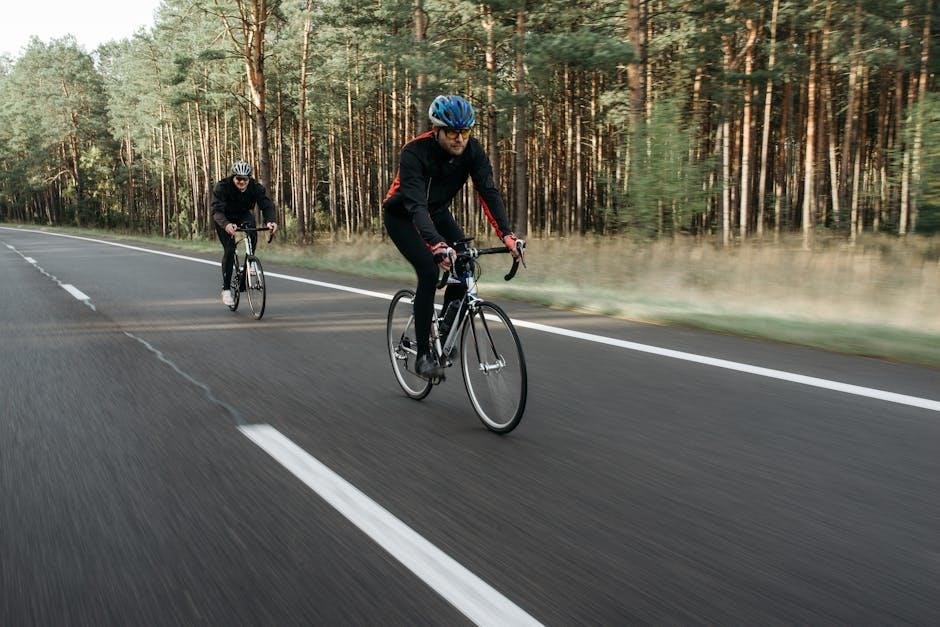
Key Considerations for Choosing the Right Road Bike Size
Measuring height, inseam, and body proportions is essential. Standover height, reach, and handlebar height also play a crucial role in ensuring comfort, efficiency, and optimal performance.
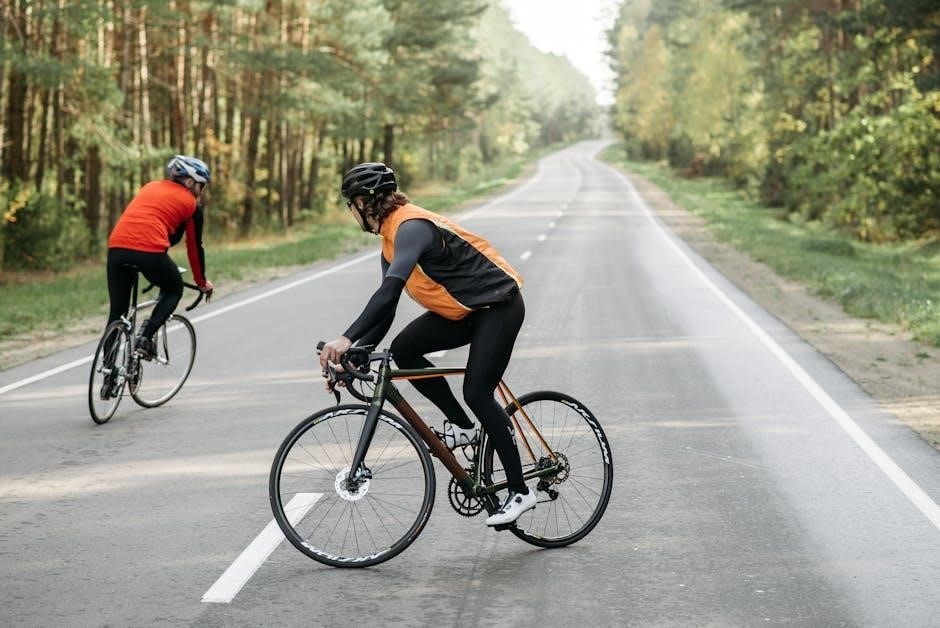
2.1 Understanding Your Height, Inseam, and Body Proportions
Accurate measurements of height, inseam, and body proportions are vital for selecting the right bike size. Your inseam determines standover clearance, while height and body proportions influence reach and handlebar height. Proper alignment ensures optimal comfort and efficiency during rides, reducing the risk of discomfort or injury. Use a size chart to match these measurements for a perfect fit.
2.2 The Role of Standover Height and Reach
Standover height ensures there’s enough clearance between you and the bike, crucial for safety and comfort. Proper reach allows you to maintain an efficient riding position, with hands comfortably on the handlebars. Balancing these factors ensures optimal control and reduces strain, making long rides more enjoyable and preventing potential discomfort or fatigue.

How to Measure Yourself for a Road Bike

Measuring yourself involves assessing inseam, height, and body proportions. Use a tape measure or standover method to ensure accurate bike sizing for optimal comfort and performance.
3.1 Step-by-Step Guide to Measuring Your Inseam
To measure your inseam, stand against a wall with your feet shoulder-width apart. Place a stiff object (like a book) between your legs, simulating a saddle. Measure the distance from the floor to the top of the object using a tape measure. Ensure the object is snug but not uncomfortable. This measurement helps determine the ideal bike size for a comfortable riding position and proper fit.
3.2 Calculating Your Ideal Handlebar Height and Reach
To determine your ideal handlebar height and reach, start by measuring the distance from your saddle to the handlebars. Use a tape measure or a specialized bike fitting tool for accuracy. Aim for a reach that allows a slight bend in your elbows, with hands in a comfortable position on the hoods or drops. Handlebar height should support your natural riding posture, balancing comfort and aerodynamics. Adjustments may vary based on riding style and body proportions.
Road Bike Size Chart: A Comprehensive Overview
This section provides detailed size charts for road bikes, categorizing them by rider height, inseam, and frame dimensions to ensure a perfect fit for optimal performance and comfort.
4.1 Men’s Road Bike Size Chart
Men’s road bike sizes typically range from 47cm to 63cm, catering to various rider heights. Here’s a breakdown:
– 47cm-49cm: Ideal for riders 5’0″-5’3″ (152cm-160cm) with a shorter inseam.
– 50cm-52cm: Suitable for 5’4″-5’6″ (160cm-168cm), offering a balanced fit.
– 53cm-55cm: Designed for 5’7″-5’9″ (170cm-175cm), providing optimal comfort.
– 56cm-58cm: Best for 5’10”-6’1″ (178cm-185cm), ensuring efficient pedaling.
– 59cm-63cm: Made for taller riders, 6’2″ and above (188cm+), with longer frames.
This chart ensures a precise fit, enhancing performance and comfort for male cyclists.
4.2 Women’s Road Bike Size Chart
Women’s road bike sizes typically range from 44cm to 56cm, tailored to fit female riders’ proportions. Here’s a detailed breakdown:
– 44cm-46cm: Ideal for riders 5’0″-5’2″ (152cm-157cm), offering a compact frame.
– 47cm-49cm: Suitable for 5’3″-5’5″ (160cm-165cm), ensuring a comfortable riding position.
– 50cm-52cm: Designed for 5’6″-5’8″ (168cm-173cm), providing efficient power transfer.
– 53cm-55cm: Best for 5’9″-6’0″ (175cm-183cm), with a balanced fit for taller riders.
– 56cm: Made for women over 6’1″ (185cm+), offering a larger frame for optimal comfort.
This chart helps women find their perfect bike fit, enhancing both performance and riding comfort.
4.3 Unisex Road Bike Size Chart
The unisex road bike size chart offers a versatile fit for all riders, regardless of gender. Frame sizes typically range from 44cm to 60cm, catering to various heights.
– 44cm-48cm: Ideal for riders 5’0″-5’4″ (152cm-163cm).
– 49cm-52cm: Suitable for 5’5″-5’7″ (165cm-170cm).
– 53cm-56cm: Designed for 5’8″-6’0″ (173cm-183cm).
– 57cm-60cm: Best for taller riders, 6’1″ and above (185cm+).
This chart ensures a comfortable and performance-oriented fit for all cyclists, emphasizing proper sizing for efficiency and enjoyment.
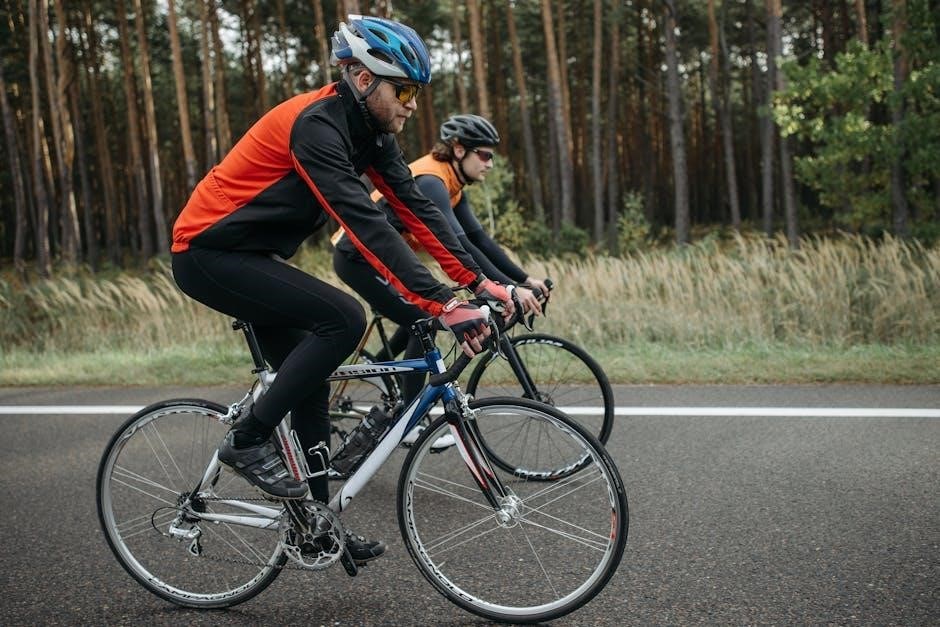
Factors Influencing Your Road Bike Fit
Handlebar height, stem length, saddle position, and wheel size significantly impact your road bike fit, affecting both comfort and performance during rides.
5.1 The Impact of Handlebar Height and Stem Length
Handlebar height and stem length play a critical role in your riding posture and comfort. A higher handlebar can reduce strain on your neck and shoulders, while a shorter stem improves maneuverability. Conversely, a lower handlebar and longer stem enhance aerodynamics, crucial for competitive riders. Balancing these elements ensures optimal performance and comfort, tailored to your riding style and goals.
5.2 Wheel Size and Its Effect on Fit and Performance
Wheel size significantly impacts both fit and performance. Smaller wheels provide better maneuverability and acceleration, while larger wheels offer stability and efficiency. Proper clearance between the frame, fork, and wheels ensures a comfortable fit and prevents mechanical issues. Riders should choose wheel sizes that align with their body proportions and riding style to optimize performance and comfort on the road.

The Importance of Proper Bike Fit for Performance and Comfort
Proper bike fit is crucial for maximizing efficiency, reducing discomfort, and preventing injury. It ensures optimal performance, enhances control, and allows riders to enjoy longer, more comfortable rides.
6.1 How a Well-Fitting Bike Enhances Your Riding Experience
A well-fitting bike significantly enhances comfort, reducing strain on the back, neck, and hands. It improves pedaling efficiency, allowing for more power with less effort. Proper alignment ensures better control and handling, making rides safer and more enjoyable. Additionally, a bike that fits well reduces the risk of injury and fatigue, enabling riders to cover longer distances with ease and confidence.
6.2 Common Issues Caused by Incorrect Bike Sizing
Incorrect bike sizing often leads to discomfort, inefficiency, and potential injury. A bike that’s too small or too large can cause poor posture, straining the neck, back, and hands. It may also result in inefficient pedaling and reduced control. Overreaching to handlebars or a saddle height that’s too high or low can cause discomfort and pain, especially in the knees and lower back, making long rides unpleasant and increasing the risk of injury.
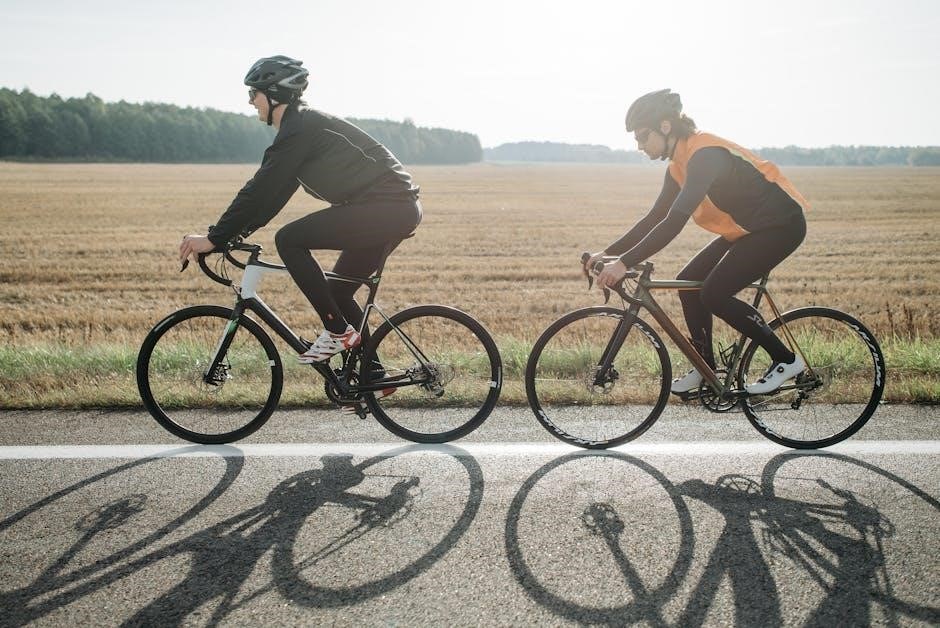
How to Test Your Road Bike for the Perfect Fit
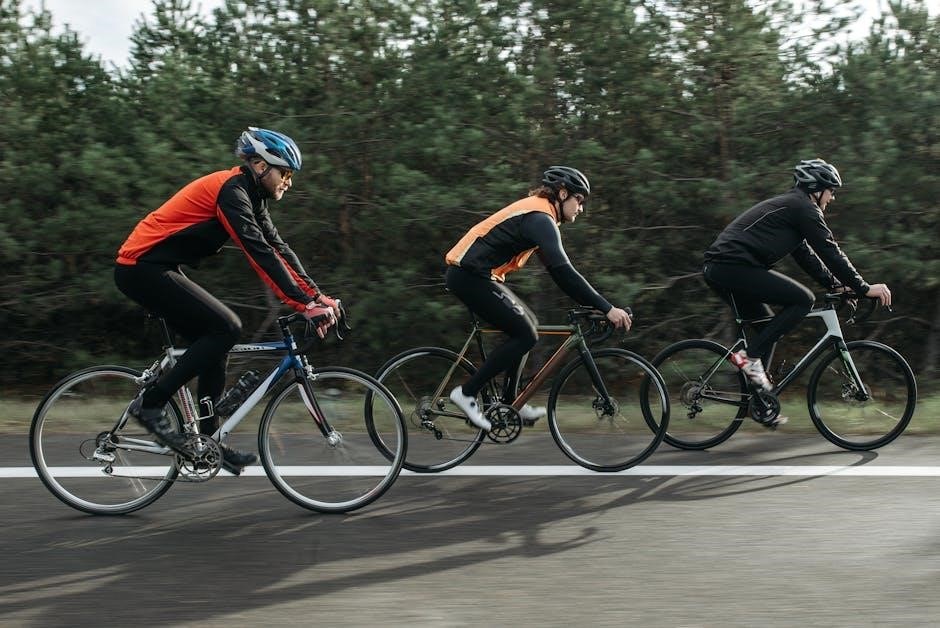
Taking a test ride is essential to evaluate comfort and efficiency. Adjusting the bike setup ensures optimal performance and a personalized fit for riders.
7.1 Tips for a Test Ride to Ensure Comfort and Efficiency
A test ride helps assess bike fit and performance. Start with a short route, checking saddle comfort, handlebar reach, and pedal efficiency. Adjust gears and brakes beforehand for smooth operation. Pay attention to posture and any discomfort. Ride on varying terrain to evaluate responsiveness and control. This ensures the bike meets your needs for both comfort and performance during extended rides. Always wear proper gear for safety.
7.2 Adjusting Your Bike Setup for Optimal Performance
Adjusting your bike setup ensures a tailored fit and enhances performance. Start with saddle height, aligning it to your hip for efficient pedaling. Position cleats for optimal foot alignment to prevent strain. Handlebar height and stem length should match your riding style, whether upright or aerodynamic. Fine-tune brake levers and gear shifters for easy access. Use tools like Allen keys for precise adjustments. Always test ride after changes to confirm comfort and efficiency.

Accessories to Fine-Tune Your Bike Fit
Accessories like handlebar tape and grips enhance comfort and control. Adjustable stems and seatposts allow customization of fit, ensuring optimal performance and riding comfort for all cyclists.
8.1 The Role of Saddle Height and Cleat Positioning
Saddle height and cleat positioning are critical for optimal performance and comfort. Proper saddle height ensures efficient leg extension, while cleat positioning affects pedaling efficiency and ergonomics. Incorrect adjustments can lead to discomfort or even injury, making precise setup essential for a superior riding experience.
8.2 Using Handlebar Tape and Grips for Comfort
Handlebar tape and grips play a vital role in enhancing comfort during long rides. They provide cushioning, reducing hand fatigue and discomfort. Available in various materials like cork, gel, and synthetic, they offer different levels of padding and grip. Properly wrapped handlebar tape ensures a secure grip, while ergonomic grips can improve control and reduce pressure on wrists and palms, contributing to a more enjoyable riding experience.
Proper bike sizing enhances performance and comfort, ensuring a seamless riding experience. Use this guide to find your perfect fit and enjoy every mile with confidence.
9.1 Final Tips for Choosing the Right Bike Size
When selecting your ideal road bike size, consider your riding style, terrain, and personal comfort. Test ride multiple sizes to ensure the best fit. A professional bike fitting can also optimize your position. Always consult a size chart specific to the brand and model. Adjust the saddle height and handlebars to suit your body proportions. Remember, the right fit enhances performance, reduces discomfort, and makes every ride enjoyable.
